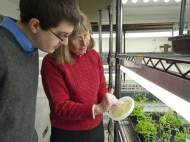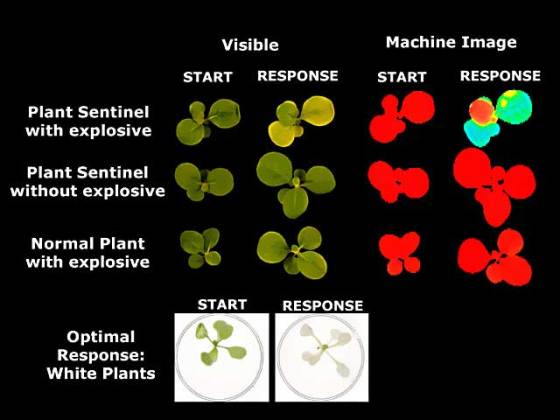Plant sentinels able to detect pollution and explosives
 A group of researchers from the Colorado State University (CSU) managed to make a computer-designed detection trait work in a plant by rewiring its natural signaling process. It enables the plant to turn from green to white when chemicals are detected in the air around it or in the soil it is planted in. The research could eventually be used for a wide range of applications such as security in airports or shopping malls, or monitoring for pollutants such as radon in a home.
A group of researchers from the Colorado State University (CSU) managed to make a computer-designed detection trait work in a plant by rewiring its natural signaling process. It enables the plant to turn from green to white when chemicals are detected in the air around it or in the soil it is planted in. The research could eventually be used for a wide range of applications such as security in airports or shopping malls, or monitoring for pollutants such as radon in a home.
“The idea to make detector plants comes directly from nature”, said lead researcher June Medford, Professor in the CSU Department of Biology. “Plants can’t run or hide from threats, so they’ve developed sophisticated systems to detect and respond to their environment. We’ve ‘taught’ plants how to detect things we’re interested in and respond in a way anyone can see, to tell us there is something nasty around.”
Computational design of Medford’s detection trait was initially done in collaboration with Professor Homme Hellinga at Duke University and more recently with Professor David Baker at the University of Washington. They used a computer program to redesign naturally occurring proteins called receptors. These re-designed receptors specifically recognize a pollutant or explosive. Medford’s lab modified these computer redesigned receptors to function in plants, and targets them to the plant cell wall. The plant detects the substance and activates an internal signal that causes the plant to lose its green color, turning the plants white. The plants do change their color back to green once the pollutant or explosive is absent.
The next goal for Medford and her team is to focus on speeding up of detection time. The initial or first-generation plants respond to an explosive in hours, but improvements are underway to reduce the response time to a few minutes. The researchers claim that the current generation of explosive and pollutant detecting plants have detection abilities that are similar to or better than those of dogs.
“Dr. Medford’s research illustrates that basic changes in scientific understanding can be applied to important problems such as environmental protection and homeland security”, said Bill Farland, vice president for Research at Colorado State and formerly top scientist at the Environmental Protection Agency.
The detection traits could be used in any plant and could detect multiple pollutants at once – changes that can also be detected by satellite. Aside the problem related to detection speed, the researchers will have to focus on better results in color change, since plants do change their color due to potential diseases or wrong watering.
For more information you can read the research article published in the peer-reviewed journal PLoS ONE named: “Programmable Ligand Detection System in Plants through a Synthetic Signal Transduction Pathway”.










Dear Sirs
Can you please contact me. I would like to ask permission to use a photo from your webside.
Best regards
Pernille Rosenkvist
Sciene Editor
Denmark
author
Hello Pernille Rosenkvist, sorry for late reply.
You’ll have to contact CSU Department of Biology.